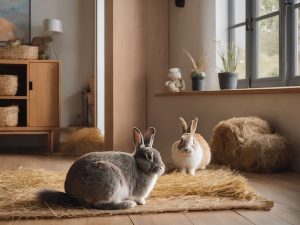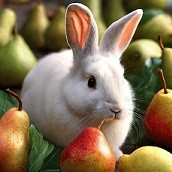Do Rabbits Eat Bluejoint Hay? Tips on Preparation & Quantity
Ah, rabbits. Those lovable, fluffy creatures that have hopped their way into our homes and hearts. Feeding them is both a joy and a responsibility. And if you’re reading this, you’re likely wondering about the mystery that is Bluejoint
What is Bluejoint Hay?
Firstly, let’s understand the hay in question. Bluejoint, scientifically named Calamagrostis canadensis, is a perennial

Can Rabbits Eat Bluejoint Hay?
To put it simply, yes, rabbits can eat Bluejoint hay. Like most other hays, Bluejoint provides essential fiber that helps in the digestive process of our furry friends. However, it’s essential to understand that while they can eat it, it might not be their first choice when compared to other more commercially available hays. Each rabbit has its own unique taste preference, so while one might enjoy it, another might turn its nose up.
How Much Bluejoint Hay Should a Rabbit Eat?
Hay, irrespective of its type, should form the lion’s share of a rabbit’s diet. Roughly 70% of their daily intake should be hay. Given the sheer amount they need to munch through, it’s always a good idea to have a fresh supply available for them at all times.
For Bluejoint hay, since it’s not as commonly fed to rabbits as, say, Timothy hay, start by introducing it in small quantities. Mix it in with their regular hay. This way, they get used to it slowly, and you can gauge their preference.
The Benefits of Bluejoint Hay
1. High in Fiber:
One of the most vital components of a rabbit’s diet is fiber. Bluejoint hay, being a grass hay, is rich in this essential nutrient, ensuring smooth digestion.
2. Natural Chewing:
Rabbits have teeth that grow continuously. Feeding them hay, including Bluejoint, allows them to naturally grind their teeth, preventing overgrowth.
3. A Different Taste:
It can be an alternative taste for bunnies who might get bored with their regular hay.
Warnings and Precautions
The hay you feed your rabbit, whether it’s Bluejoint or another type, should always be of high quality. This means it should be free from mold, pesticides, and any other contaminants. Storing hay in a dry place is crucial, as damp hay can become a breeding ground for mold.
Alternatives and Similar Foods
While Bluejoint hay can be an addition to a rabbit’s diet, there are several other hays that are more commonly recognized and appreciated by our long-eared companions:
- Timothy Hay: Often considered the gold standard for rabbits due to its perfect fiber to protein ratio.
- Meadow Hay: A mix of various grasses, providing diverse flavors and textures.
- Orchard Grass: A softer hay that’s high in fiber and quite palatable.
And, when it comes to treats, there’s the delightful world of fruits. Although
Tips on Preparation
If you’re considering introducing Bluejoint hay to your rabbit, here are a few preparation tips:
1. Mix and Match:
Combine Bluejoint hay with their current hay to help them acclimate to the new flavor.
2. Freshness is Key:
Always ensure the hay is fresh and free from mold. Regularly inspecting and replacing old hay is essential.
3. Observe and Adapt:
Watch your rabbit’s reaction to Bluejoint hay. If they seem to like it, that’s great! If not, there’s no need to force it. Every bunny has its unique preferences.
Conclusion
Bluejoint hay, while not as prevalent in rabbit diets as other types, can be a nutritious and safe option. As with all things concerning our pets, observation, quality assurance, and care are paramount. Offering a diverse diet ensures that our rabbit friends remain healthy, happy, and hopping for a long time!
Bluejoint Hay and Its Nutrition
| Feature | Description | References |
|---|---|---|
| Can rabbits eat Bluejoint Hay? | Yes, rabbits can eat Bluejoint Hay. It is a good source of fiber and can help with digestion. | 1 |
| Nutritional value | Bluejoint Hay is low in protein and high in fiber, making it a good choice for rabbits. | 1 |
| Serving size | Rabbits should be given a small amount of hay daily, about the size of their body. | 1 |







Leave a Reply